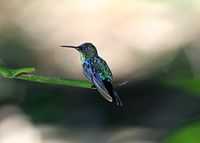Violet-crowned Woodnymph
| Violet-crowned Woodnymph | |
|---|---|
 | |
| Male | |
_taxobox.jpg) | |
| Female | |
| Conservation status | |
| Scientific classification | |
| Kingdom: | Animalia |
| Phylum: | Chordata |
| Class: | Aves |
| Order: | Apodiformes |
| Family: | Trochilidae |
| Genus: | Thalurania |
| Species: | T. colombica |
| Trinomial name | |
| Thalurania colombica colombica (Bourcier, 1843) | |
The Violet-crowned Woodnymph (Thalurania colombica colombica), also known as the Purple-crowned Woodnymph, is a medium-sized hummingbird found from Guatemala and Belize to northern Colombia and western Venezuela. It is now considered by the AOU as the nominate subspecies of the Crowned Woodnymph.
The Violet-crowned Woodnymph is a common to abundant bird of wet lowlands and foothills to 2500 m, and may move higher when not breeding. The female Violet-crowned Woodnymph is entirely responsible for nest building and incubation. She lays two white eggs in a plant-fibre cup nest 1–5 m high on a horizontal branch. Incubation takes 15–19 days, and fledging another 20-26.

The adult male Violet-crowned Woodnymph is 10.2 cm long and weighs 4.5 g. It has a violet crown, upper back, shoulders and belly, a shiny green throat and breast, green lower back, and a deeply forked blue-black tail. The female is 8.4–9 cm long and weighs 3.5 g. She is bright green above and duller green below, with a grey throat and breast. Her tail is rounded, mainly green near the body but with a blue-black lower half and white corners. Young males lack any violet or iridescence and are bronze-coloured below. Immature females have buff fringes on the feathers of the nape, face and rump. The call is a high-pitched fast kip.

The food of this species is nectar, taken from a variety of flowers. Males feed in the canopy, where their food plants include epiphytic Ericaceae and bromeliads, and defend flowers and scrubs in their feeding territories. Females stay in the understory. After breeding, both sexes may concentrate at Heliconias. Like other hummingbirds, Violet-crowned Woodnymph also takes small insects and spiders as an essential source of protein.
References
- ↑ BirdLife International (2012). "Thalurania colombica". IUCN Red List of Threatened Species. Version 2012.1. International Union for Conservation of Nature. Retrieved 16 July 2012.
- Hilty, Birds of Venezuela, ISBN 0-7136-6418-5
- Stiles and Skutch, A guide to the birds of Costa Rica ISBN 0-8014-9600-4
External links
- Article w/RangeMaps Infonatura NatureServe
